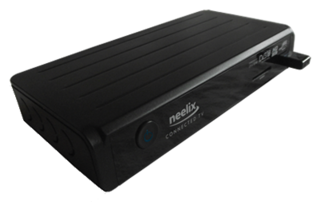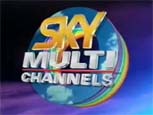
Phase Alternating Line (PAL) is a colour encoding system for analogue television. It was one of three major analogue colour television standards, the others being NTSC and SECAM. In most countries it was broadcast at 625 lines, 50 fields per second, and associated with CCIR analogue broadcast television systems B, D, G, H, I or K. The articles on analog broadcast television systems further describe frame rates, image resolution, and audio modulation.

A set-top box (STB), also colloquially known as a cable box or receiver and historically television decoder, is an information appliance device that generally contains a TV-tuner input and displays output to a television set and an external source of signal, turning the source signal into content in a form that can then be displayed on the television screen or other display device. They are used in cable television, satellite television, and over-the-air television systems as well as other uses.

SCART is a French-originated standard and associated 21-pin connector for connecting audio-visual (AV) equipment. The name SCART comes from Syndicat des Constructeurs d'Appareils Radiorécepteurs et Téléviseurs, "Radio and Television Receiver Manufacturers' Association", the French organisation that created the connector in the mid-1970s. The related European standard EN 50049 has then been refined and published in 1978 by CENELEC, calling it péritelevision, but it is commonly called by the abbreviation péritel in French.
Regular television broadcasts in the United Kingdom started in 1936 as a public service which was free of advertising, which followed the first demonstration of a transmitted moving image in 1926. Currently, the United Kingdom has a collection of free-to-air, free-to-view and subscription services over a variety of distribution media, through which there are over 480 channels for consumers as well as on-demand content. There are six main channel owners who are responsible for most material viewed.

Terrestrial television or over-the-air television (OTA) is a type of television broadcasting in which the signal transmission occurs via radio waves from the terrestrial (Earth-based) transmitter of a TV station to a TV receiver having an antenna. The term terrestrial is more common in Europe and Latin America, while in Canada and the United States it is called over-the-air or simply broadcast. This type of TV broadcast is distinguished from newer technologies, such as satellite television, in which the signal is transmitted to the receiver from an overhead satellite; cable television, in which the signal is carried to the receiver through a cable; and Internet Protocol television, in which the signal is received over an Internet stream or on a network utilizing the Internet Protocol. Terrestrial television stations broadcast on television channels with frequencies between about 52 and 600 MHz in the VHF and UHF bands. Since radio waves in these bands travel by line of sight, reception is generally limited by the visual horizon to distances of 64–97 kilometres (40–60 mi), although under better conditions and with tropospheric ducting, signals can sometimes be received hundreds of kilometers distant.
PALplus is an analogue television broadcasting system aimed to improve and enhance the PAL format by allowing 16:9 aspect ratio broadcasts, while remaining compatible with existing television receivers, defined by ITU recommendation BT.1197-1. Introduced in 1993, it followed experiences with the HD-MAC and D2-MAC, hybrid analogue-digital widescreen formats that were incompatible with PAL receivers. It was developed at the University of Dortmund in Germany, in cooperation with German terrestrial broadcasters and European and Japanese manufacturers. The system had some adoption across Europe during the late 1990s and helped introduce widescreen TVs in the market, but never became mainstream.
Viaccess is a conditional access system edit by Orange S.A. There are six versions in use today, Viaccess PC2.3, Viaccess PC2.4, Viaccess PC2.5, Viaccess PC2.6, Viaccess ACS3.x/Prime Sentinel, Viaccess ACS4.1, Viaccess ACS5.0, and Viaccess ACS6.x/Adaptive Sentinel.
VideoGuard, produced by NDS, is a digital encryption system for use with conditional access television broadcasting. It is used on digital satellite television systems - some of which are operated by News Corporation, which owned about half (49%) of NDS until its sale to Cisco in 2012. Since 2018 VideoGuard is improved and maintained by Synamedia. Its two most widely used implementations are Sky in the United Kingdom and Ireland and DirecTV in the United States, the former of which launched the digital version of the system in 1998.
Television encryption, often referred to as scrambling, is encryption used to control access to pay television services, usually cable, satellite, or Internet Protocol television (IPTV) services.
Conditional access (CA) is a term commonly used in relation to software and to digital television systems. Conditional access is that ‘just-in-time’ evaluation to ensure the person who is seeking access to content is authorized to access the content. Said another way, conditional access is a type of access management. Access is managed by requiring certain criteria to be met before granting access to the content.

Multiplexed Analogue Components (MAC) was an analog television standard where luminance and chrominance components were transmitted separately. This was an evolution from older color TV systems where there was interference between chrominance and luminance.
Zweikanalton or A2 Stereo, is an analog television sound transmission system used in Germany, Austria, Australia, Switzerland, Netherlands and some other countries that use or used PAL-B or PAL-G. TV3 Malaysia formerly used Zweikanalton on its UHF analogue transmission frequency, while NICAM was instead used on its VHF analogue transmission frequency. South Korea also formerly utilised a modified version of Zweikanalton for its NTSC analogue television system until 31 December 2012. It relies on two separate FM carriers.

In television electronics, A-MAC carries digital information: sound, and data-teletext on an FM subcarrier at 7 MHz. Since the vision bandwidth of a standard MAC signal is 8.4 MHz, the horizontal resolution on A-MAC has to be reduced to make room for the 7 MHz carrier. A-MAC has not been used in service.

B-MAC is a form of analog video encoding, specifically a type of Multiplexed Analogue Components (MAC) encoding. MAC encoding was designed in the mid 80s for use with Direct Broadcast Satellite systems. Other analog video encoding systems include NTSC, PAL and SECAM. Unlike the FDM method used in those, MAC encoding uses a TDM method. B-MAC was a proprietary MAC encoding used by Scientific-Atlanta for encrypting broadcast video services; the full name was "Multiple Analogue Component, Type B".

C-MAC is the television technology variant approved by the European Broadcasting Union (EBU) for satellite transmissions. The digital information is modulated using 2-4PSK, a variation of quadrature PSK where only two of the phaser angles (±90°) are used.

Among the family of MAC or Multiplexed Analogue Components systems for television broadcasting, D-MAC is a reduced bandwidth variant designed for transmission down cable.

D2-MAC is a satellite television transmission standard, a member of Multiplexed Analogue Components family. It was created to solve D-MAC's bandwidth usage by further reducing it, allowing usage of the system on cable and satellite broadcast. It could carry four high quality sound channels or eight lower quality audio channels. It was adopted by Scandinavian, German and French satellite broadcasts. The system was used until July 2006 in Scandinavia and until the mid-1990s for German and French sound channels.

Sky Multichannels was a package of analogue television services offered by BSkyB on the Astra satellites at 19.2° east from 1 September 1993 to 27 September 2001, which started off with 15 channels before expanding to over 40.
In North American digital terrestrial television broadcasting, a distributed transmission system is a form of single-frequency network in which a single broadcast signal is fed via microwave, landline, or communications satellite to multiple synchronised terrestrial radio transmitter sites. The signal is then simultaneously broadcast on the same frequency in different overlapping portions of the same coverage area, effectively combining many small transmitters to generate a broadcast area rivalling that of one large transmitter or to fill gaps in coverage due to terrain or localised obstacles.

Telecommunication, often used in its plural form, is the transmission of information by various types of technologies over wire, radio, optical, or other electromagnetic systems. It has its origin in the desire of humans for communication over a distance greater than that feasible with the human voice, but with a similar scale of expediency; thus, slow systems are excluded from the field.






